Peel-and-stick wallpaper is easy to install, reposition, and remove without mess, making it perfect for quick updates and DIY projects. Traditional wallpaper needs more prep, adhesives, and longer installation time but lasts longer and offers more detailed patterns. Peel-and-stick is less durable but more reusable and environmentally friendly. The right choice depends on your wall type, style, and budget. Explore further to understand which option best fits your space and needs.
Key Takeaways
- Peel-and-stick wallpaper offers easy installation, repositioning, and removal, while traditional wallpaper requires paste and smoothing processes.
- Surface preparation for both is essential, but peel-and-stick is more forgiving and less messy during application.
- Peel-and-stick provides a wide variety of modern designs, whereas traditional wallpaper features classic, detailed patterns.
- Peel-and-stick is generally more affordable, easier to maintain, and environmentally friendly compared to traditional wallpaper.
- Traditional wallpaper tends to last longer (10+ years) and is more durable on textured or high-moisture surfaces than peel-and-stick options.
Application Process and Ease of Installation
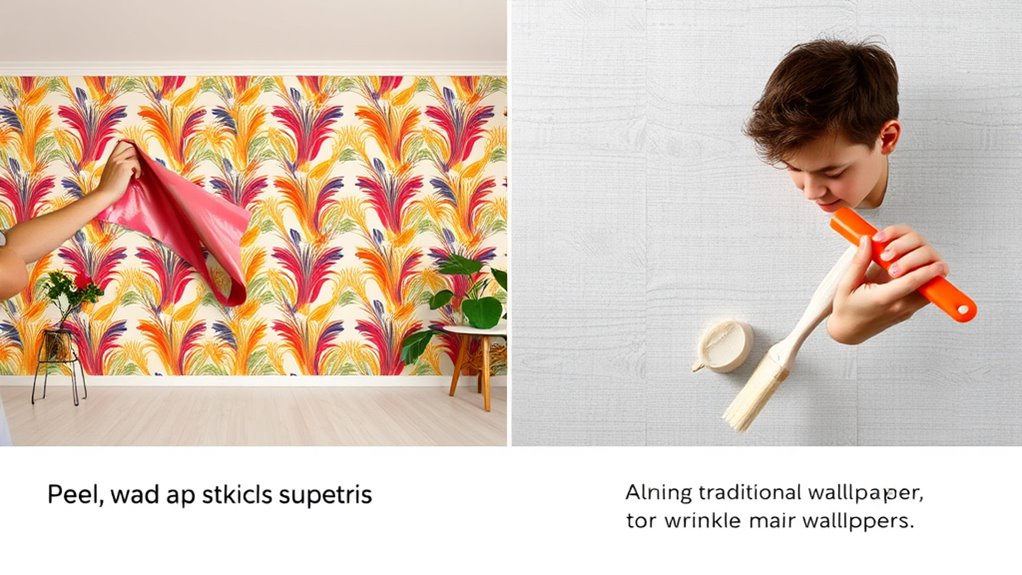
When comparing peel-and-stick wallpaper to traditional options, the application process is often the most noticeable difference. Peel-and-stick wallpaper is designed for quick, straightforward installation. You simply peel off the backing, position the wallpaper, and press it onto the wall. This makes the process less messy and reduces the need for tools like paste brushes or smoothing tools. Plus, the removal ease offers an advantage—peel-and-stick can be taken down without damaging the wall, making reapplication potential ideal for renters or those who like to change decor frequently. Traditional wallpaper requires paste, smoothing, and more time-consuming steps. Overall, peel-and-stick provides a hassle-free experience, especially if you’re looking for a quick, adjustable, and less permanent decorating solution. Additionally, peel-and-stick wallpaper allows for easy customization and repositioning, which is often difficult with traditional methods. Its removability makes it a popular choice for temporary updates or rental spaces, and understanding the application process can help ensure a successful installation. A durability factor also influences the decision, as peel-and-stick options are often resistant to minor impacts and moisture, adding to their convenience.
Surface Preparation Requirements

Surface preparation is essential for both peel-and-stick and traditional wallpaper to adhere properly and last longer. You need a smooth, clean surface to ensure successful application. For texture options, removing bumps or rough patches helps create an even background. Properly primed walls allow for better color matching, preventing uneven shades or peeling. Additionally, understanding AI in Education can inform better methods for assessing and improving surface conditions with technological tools. Using appropriate tools like moisture meters can help verify that the wall is sufficiently dry and ready for wallpaper application. Incorporating surface testing methods ensures an optimal foundation for lasting wallpaper adhesion. Conducting surface inspections before applying wallpaper can identify potential issues early and improve overall results.
Removal and Reusability

Removing wallpaper can be a straightforward process if you choose the right method, especially since peel-and-stick options are designed for easy removal. With peel-and-stick wallpaper, reusability concerns are minimal—you can often peel it off and reposition it without much damage. This makes removal much less difficult compared to traditional wallpaper, which may require steaming, scrapers, or chemical removers and can cause wall damage. Traditional wallpaper tends to have higher removal difficulty, and once taken down, it’s usually unusable due to adhesive residue or tearing. If you value the ability to reuse your wallpaper, peel-and-stick offers a clear advantage. It allows for quick, clean removal and potential repositioning, making it a more convenient choice for temporary or changing decor needs. Additionally, GMC tuning techniques demonstrate that choosing materials and methods designed for easy handling can significantly simplify the process. When selecting wallpaper, considering removability features can further enhance ease of maintenance and reusability.
Design Variety and Customization Options
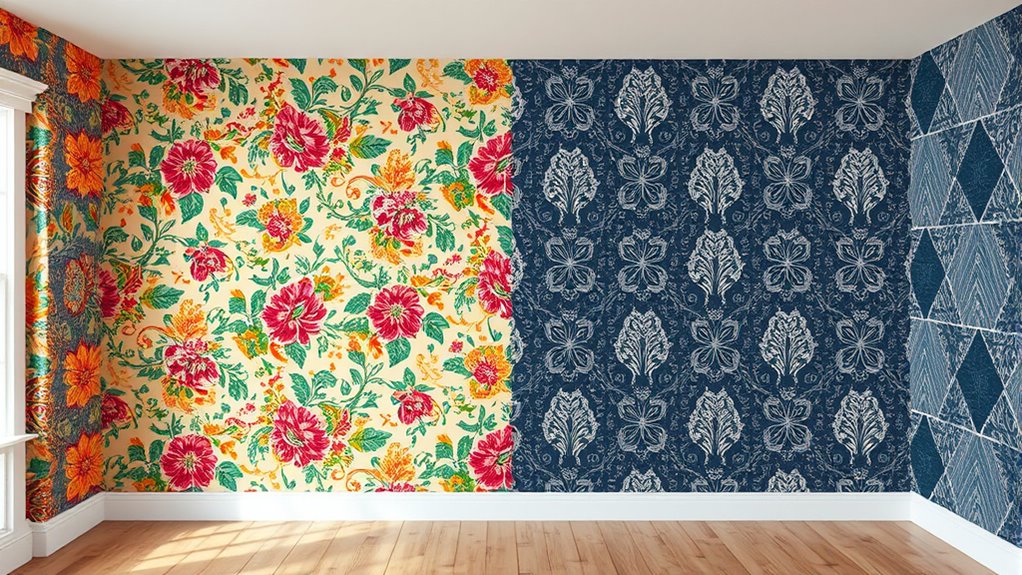
Have you considered how much your wallpaper choices can influence the look of your space? Both peel-and-stick and traditional wallpaper offer diverse design options, but they differ in pattern variety and color options. Peel-and-stick wallpapers often feature modern, trendy designs with quick customization, allowing you to choose from a wide range of patterns and colors. Traditional wallpaper may offer a more classic, intricate style, but with less flexibility in customization. Here’s a quick comparison:
| Feature | Peel‑And‑Stick | Traditional Wallpaper |
|---|---|---|
| Pattern Variety | Extensive, modern designs | Classic, detailed patterns |
| Color Options | Wide, customizable palette | Limited, fixed color schemes |
| Ease of Customization | High, easy to change or update | Less flexible, permanent installation |
| Design Flexibility | Instant, removable, repositionable | Permanent, more complex removal |
| Personalization | Custom prints possible | Usually pre-made designs |
Additionally, peel-and-stick wallpaper can be a great DIY project for homeowners seeking quick updates without professional help, especially in versatile spaces like a bedroom. The ease of installation also reduces the need for professional tools, making it accessible for most DIY enthusiasts. Considering the ease of removal, peel-and-stick options are ideal for renters or those who like to change their decor frequently.
Durability and Longevity
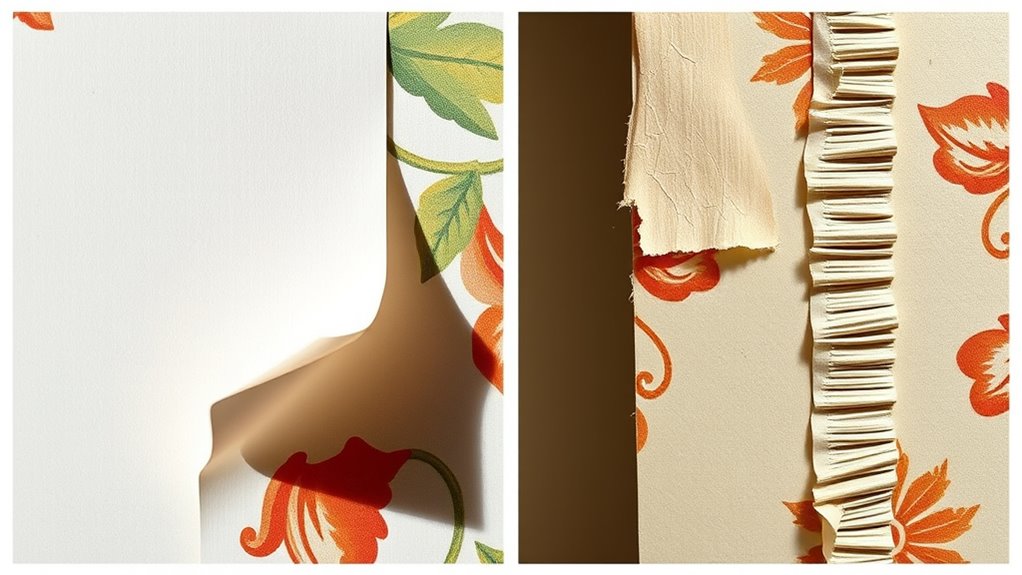
You want your wallpaper to last, so it’s important to ensure how well it resists wear over time. Strong adhesion and durable materials ensure your wallcovering stays in place and looks good longer. Understanding these factors helps you choose the right option for lasting beauty. Additionally, selecting high-quality materials can significantly enhance the longevity and durability of your wallpaper. Considering protective styling benefits from related craft techniques can also inspire choices that extend the lifespan of your decor. Being aware of signs of spoilage in materials can also help prevent premature damage or deterioration of wallpaper.
Resistance to Wear
When it comes to resistance to wear, peel-and-stick wallpaper generally offers comparable durability to traditional wallpaper, but there are key differences. Peel-and-stick options often excel in scratch durability, resisting minor abrasions better with proper care. Fading resistance varies depending on the material and exposure to sunlight; some peel-and-stick wallpapers are UV-coated for enhanced longevity. Additionally, material quality plays a significant role in the overall durability of wallpaper options. Traditional wallpaper, however, may last longer if professionally applied with high-quality materials. Here’s a quick comparison:
| Feature | Peel-and-Stick | Traditional Wallpaper |
|---|---|---|
| Fading Resistance | Good with UV coating | Varies, often less UV protection |
| Scratch Durability | Generally high with vinyl layers | Moderate, depends on material |
| Longevity | 3–5 years with care | 10+ years, if maintained |
Incorporating professional installation can also influence the lifespan of traditional wallpaper, ensuring proper adhesion and reducing wear over time. Choosing based on wear resistance depends on your environment and usage. For environments with high foot traffic or exposure to elements, durability considerations such as UV protection become increasingly important.
Adhesion Strength
Adhesion strength plays a crucial role in determining the durability and longevity of wallpaper. When you perform adhesion testing, you assess how well the wallpaper adheres over time, revealing its true sticking power. Peel‑and‑stick wallpapers often undergo rigorous adhesion testing to ensure their adhesive longevity, meaning they stay securely in place longer without peeling or lifting. Traditional wallpaper relies on a strong adhesive applied during installation, but its longevity can vary based on factors like surface preparation and environmental conditions. Better adhesion strength means your wallpaper resists peeling, bubbling, and damage, extending its lifespan. Additionally, the presence of effective adhesive ingredients like specific polymers can enhance the overall sticking power. Adhesive formulation plays a significant role in how well the wallpaper adheres under different conditions. Recognizing the importance of adhesion testing can help you select a product with sufficient adhesive longevity for your space, ensuring it remains intact over time. Incorporating glycolic acid in skincare formulations demonstrates how specific active ingredients can improve product performance and skin results.
Material Longevity
Material longevity determines how well your wallpaper withstands daily wear, environmental factors, and the passage of time. Peel‑and‑stick wallpaper generally offers good material durability, especially with modern, high-quality options designed for longevity. Its wear resistance allows it to handle minor bumps, cleaning, and occasional contact without tearing or fading quickly. Traditional wallpaper, however, often has a longer lifespan due to thicker, more durable materials like vinyl or textured papers. These materials resist peeling, moisture, and fading better over time. Whether you choose peel‑and‑stick or traditional wallpaper, understanding their material durability helps you select a solution that matches your lifestyle and environment, ensuring your walls stay vibrant and intact for years.
Suitability for Different Wall Types
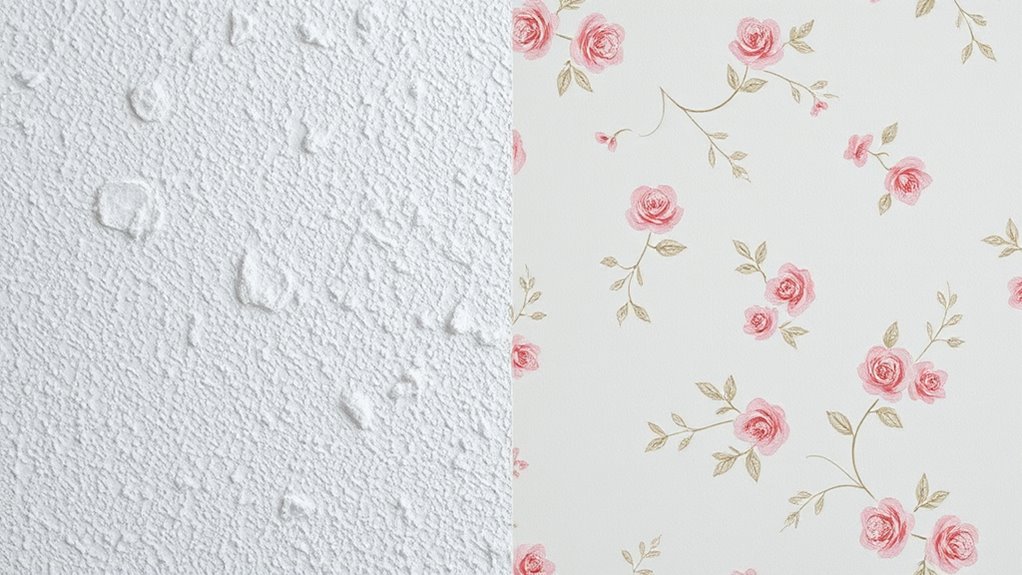
Choosing the right wallpaper depends largely on your wall type, as each surface responds differently to peel-and-stick and traditional options. If your wall has smooth, even wall texture, both types work well, but peel-and-stick is easier to install and remove. For textured walls, traditional wallpaper adheres better, especially if the surface is uneven or rough. Moisture sensitivity also matters—peel-and-stick wallpapers are less suitable for high-humidity areas like bathrooms, as they may peel or bubble. In contrast, traditional wallpaper often requires a primer or special adhesive to guarantee proper adhesion on moisture-prone walls. Assess your wall texture and moisture levels before choosing; doing so helps ensure your wallpaper stays intact and looks great longer.
Cost Considerations
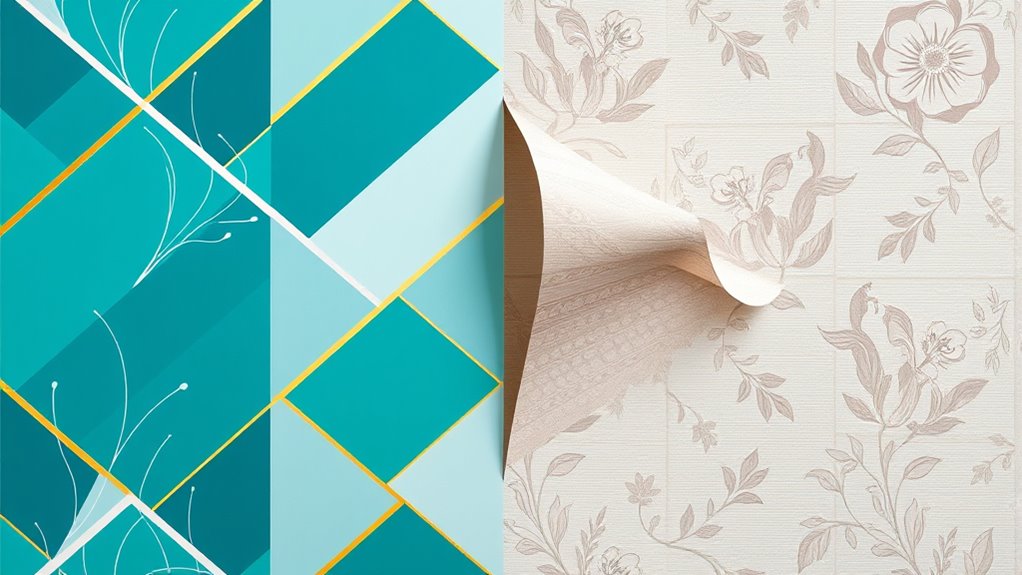
When weighing your wallpaper options, cost is a key factor to contemplate. Peel-and-stick wallpapers often have lower initial costs due to easier installation, reducing labor expenses. Traditional wallpaper, however, can be pricier upfront because of installation challenges and the need for professional help. Long-term maintenance also impacts costs; peel-and-stick options are typically easier to remove and clean, saving you money over time. Conversely, traditional wallpaper may require more effort for repairs or removal, increasing your overall expenses. Here’s a quick comparison:
| Aspect | Peel-and-Stick | Traditional Wallpaper |
|---|---|---|
| Initial Cost | Lower | Higher |
| Installation Challenges | Minimal | More complex |
| Long-term Maintenance | Easier to manage | More labor-intensive |
| Removal | Simple | Potentially costly |
| Repairs | Easy to fix | More difficult |
Environmental Impact and Safety
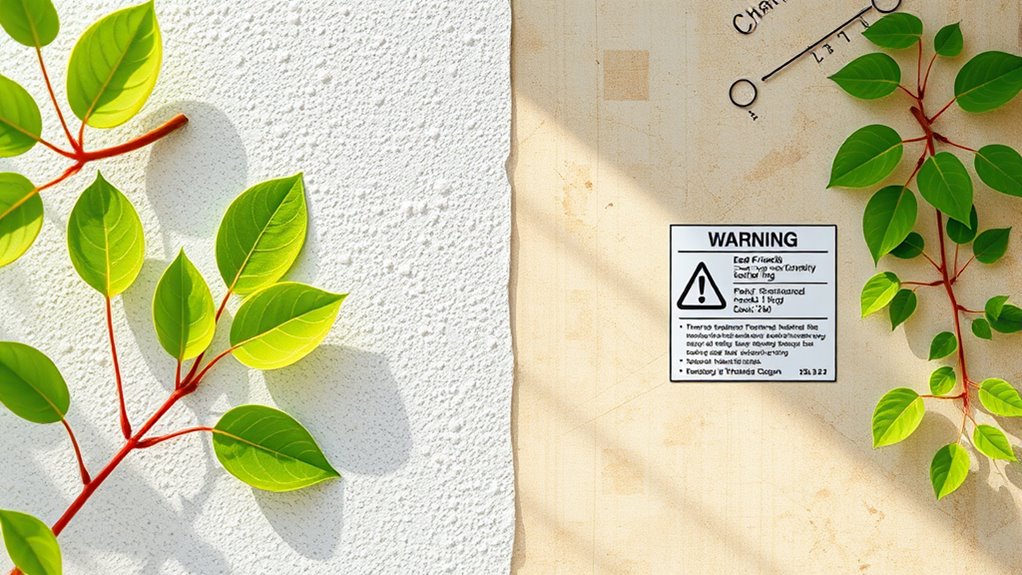
While peel-and-stick wallpapers are praised for their convenience, their environmental impact and safety considerations also play a significant role in your decision. Many peel-and-stick options now use eco-friendly materials, reducing your carbon footprint and minimizing waste. These wallpapers often avoid volatile organic compounds (VOCs), making them safer for indoor air quality and reducing chemical safety concerns. Traditional wallpaper may contain adhesives and dyes with harmful chemicals, which can off-gas over time. Choosing peel-and-stick versions with eco-friendly components helps ensure your home remains healthier while also being more environmentally conscious. However, it’s essential to review product labels and certifications to verify claims about chemical safety and eco-friendliness, so you make an informed decision that aligns with your values.
Ideal Spaces and Decorating Styles

Your decorating style can influence whether peel-and-stick or traditional wallpaper works best. Modern and transitional looks often favor the quick updates of peel-and-stick, while vintage or eclectic spaces might embrace the charm of traditional options. Minimalist and contemporary designs typically lean toward sleek, simple patterns that both types of wallpaper can achieve effortlessly.
Modern and Transitional Looks
Modern and seamless looks effortlessly blend clean lines with subtle elegance, making them ideal choices for a variety of spaces. Peel‑and‑stick wallpaper with textured finishes adds depth without overwhelming the design, perfect for creating a sophisticated yet understated atmosphere. These styles emphasize simplicity and balance, allowing you to focus on color matching to enhance your decor. With modern and transitional wallpapers, you can easily coordinate shades to complement furniture and accessories, ensuring a cohesive look. The flexibility of peel‑and‑stick options makes it simple to update your space as trends evolve, while traditional wallpaper can offer a more refined texture. Whether you prefer sleek minimalism or soft transitional aesthetics, these wallpapers provide an effortless way to achieve a contemporary or transitional vibe.
Vintage and Eclectic Vibes
Vintage and eclectic vibes bring a bold, personalized touch to any space, making them perfect for showcasing creativity and history. You can celebrate antique charm and vintage patterns to create a unique atmosphere. To enhance your space, consider these ideas:
- Use wallpaper with vintage patterns to evoke nostalgia and charm.
- Mix antique furniture pieces for a curated, eclectic look.
- Incorporate bold colors and patterns to emphasize personality.
- Display collected items and heirlooms for a truly personalized space.
These approaches allow you to highlight the richness of history while maintaining a lively, individual style. Whether you’re decorating a living room, bedroom, or accent wall, embracing vintage and eclectic vibes makes your space feel warm, inviting, and uniquely yours.
Minimalist and Contemporary Styles
Minimalist and contemporary styles focus on clean lines, uncluttered spaces, and functional design, making them ideal for creating calming, streamlined environments. To enhance these spaces, consider incorporating textural contrast—such as pairing smooth surfaces with tactile finishes—to add subtle visual interest without clutter. Color coordination is essential; sticking to a neutral palette with pops of muted tones helps maintain the serene vibe these styles demand. Peel-and-stick wallpaper offers an easy way to introduce understated patterns or textures without overwhelming the space. It allows you to experiment with subtle variations in finish or tone, enriching the minimalist aesthetic. Traditional wallpaper, on the other hand, may add more visual weight, so choose designs carefully to preserve the clean, modern look you’re after.
Frequently Asked Questions
Can Peel‑And‑Stick Wallpaper Be Repositioned Easily During Installation?
Yes, peel‑and‑stick wallpaper offers excellent repositioning flexibility during installation. You can easily lift and reposition it without damaging the adhesive or the wall, making the installation process much easier and less stressful. This flexibility allows you to perfect your placement before pressing it firmly into place. So, if you need to adjust your wallpaper during installation, peel‑and‑stick options make it simple and hassle-free, enhancing your overall installation experience.
How Does Wall Temperature Affect Peel‑And‑Stick Wallpaper Adhesion?
Wall temperature critically impacts peel-and-stick wallpaper adhesion because thermal expansion can weaken the adhesive, especially if it’s too hot or cold. When the temperature is outside the recommended range, the adhesive temperature may decrease, reducing sticking power. To guarantee strong adhesion, install the wallpaper in a room with stable, moderate temperature, avoiding extreme heat or cold, which can compromise the adhesive’s effectiveness and lead to peeling over time.
Are There Any Health Concerns With Traditional Wallpaper Adhesives?
Traditional wallpaper adhesives can pose health risks due to chemical exposure, especially if you’re sensitive or have allergies. Some adhesives contain volatile organic compounds (VOCs) that may cause respiratory irritation or skin reactions. To minimize these health concerns, make certain proper ventilation during application, choose low or no-VOC adhesives, and follow manufacturer instructions carefully. Being aware of potential chemical exposure helps protect your health while decorating your space.
What Are the Best Cleaning Methods for Peel‑And‑Stick Wallpaper?
To clean peel‑and‑stick wallpaper, start with gentle surface preparation by dusting or vacuuming to remove loose dirt. Use soft cloths or sponges with mild soap and water for cleaning, avoiding harsh chemicals that could damage the adhesive. Gently wipe the surface, and avoid excessive moisture. Always test a small area first to make certain it won’t affect the wallpaper’s integrity. Regular maintenance keeps your wallpaper looking fresh and vibrant.
How Do Peel‑And‑Stick Wallpapers Handle Moisture in Humid Environments?
Peel‑and‑stick wallpapers generally handle moisture and humidity better than traditional options, thanks to their moisture resistance and humidity tolerance. You’ll find they resist warping or peeling in damp environments like kitchens and bathrooms. However, avoid prolonged exposure to excessive moisture, which can weaken adhesives over time. To maximize durability, guarantee surfaces are clean and dry before application, and consider sealing edges for added moisture resistance in high-humidity areas.
Conclusion
Ultimately, choosing between peel-and-stick and traditional wallpaper comes down to your personal preferences and the ambiance you wish to create. While peel-and-stick offers a modern, effortless touch, traditional wallpaper can bring timeless elegance with a bit more commitment. Both options have their own charm, allowing you to craft your space thoughtfully. Whichever you select, you’ll find a way to enhance your home’s character with a subtle touch of sophistication and style.









